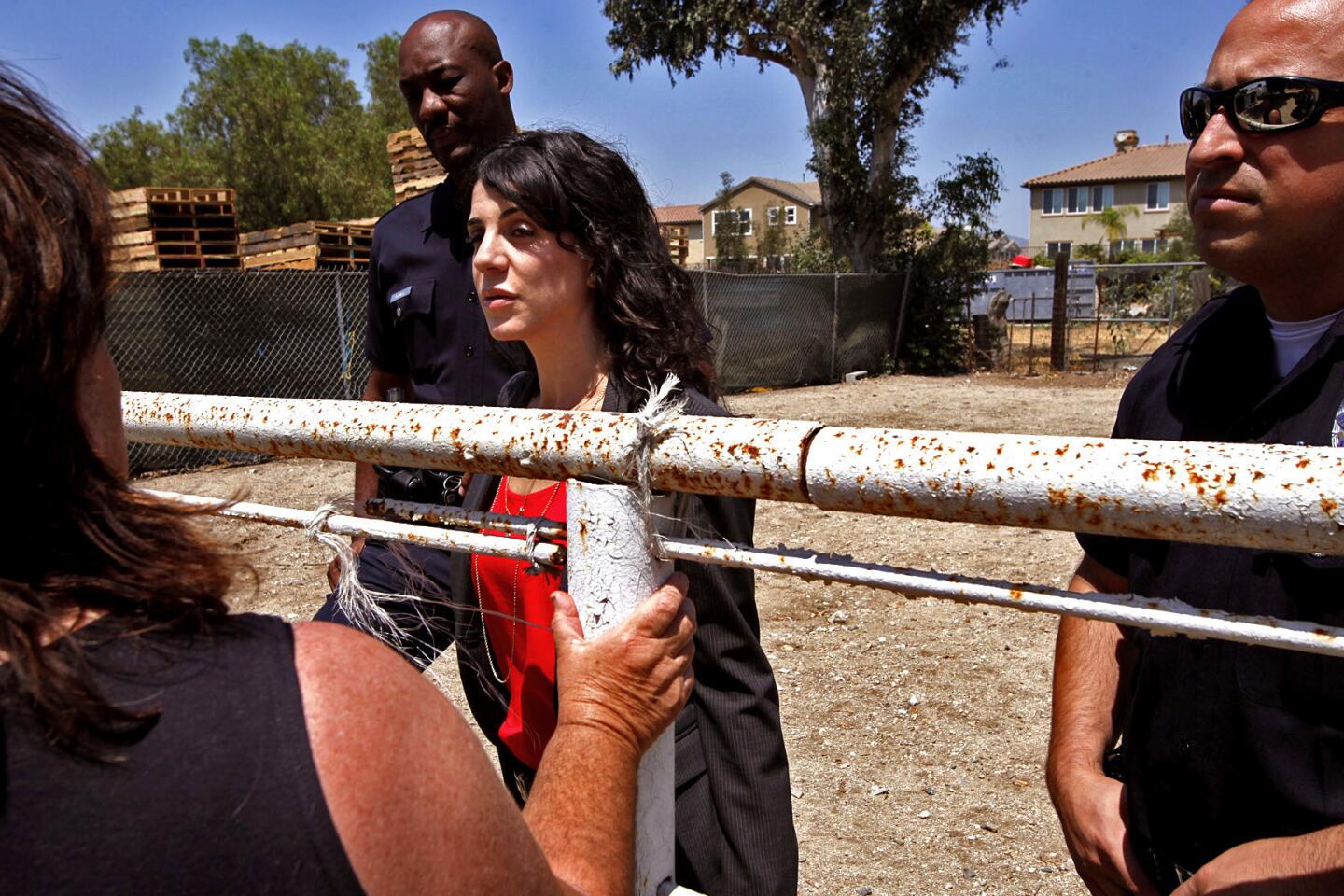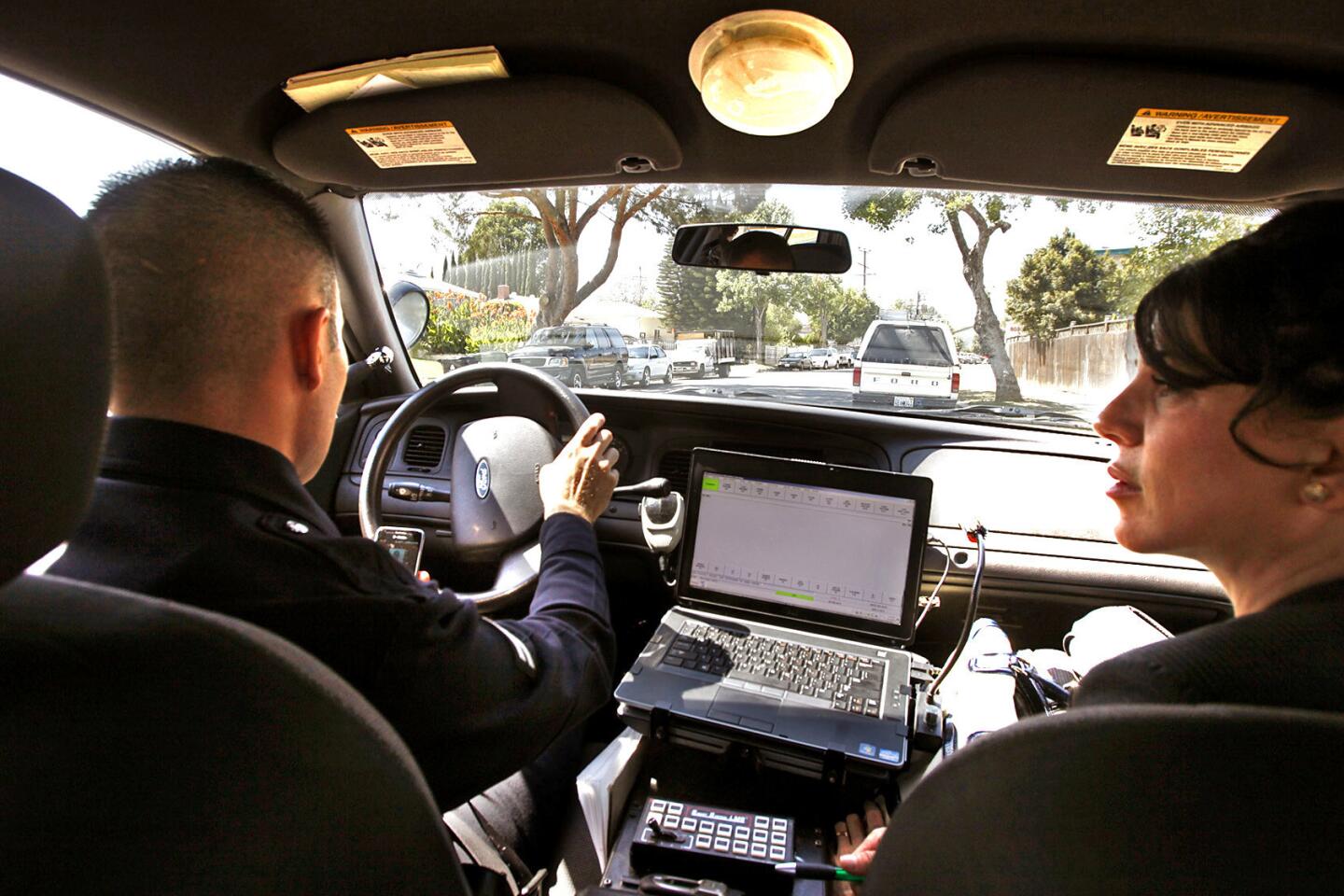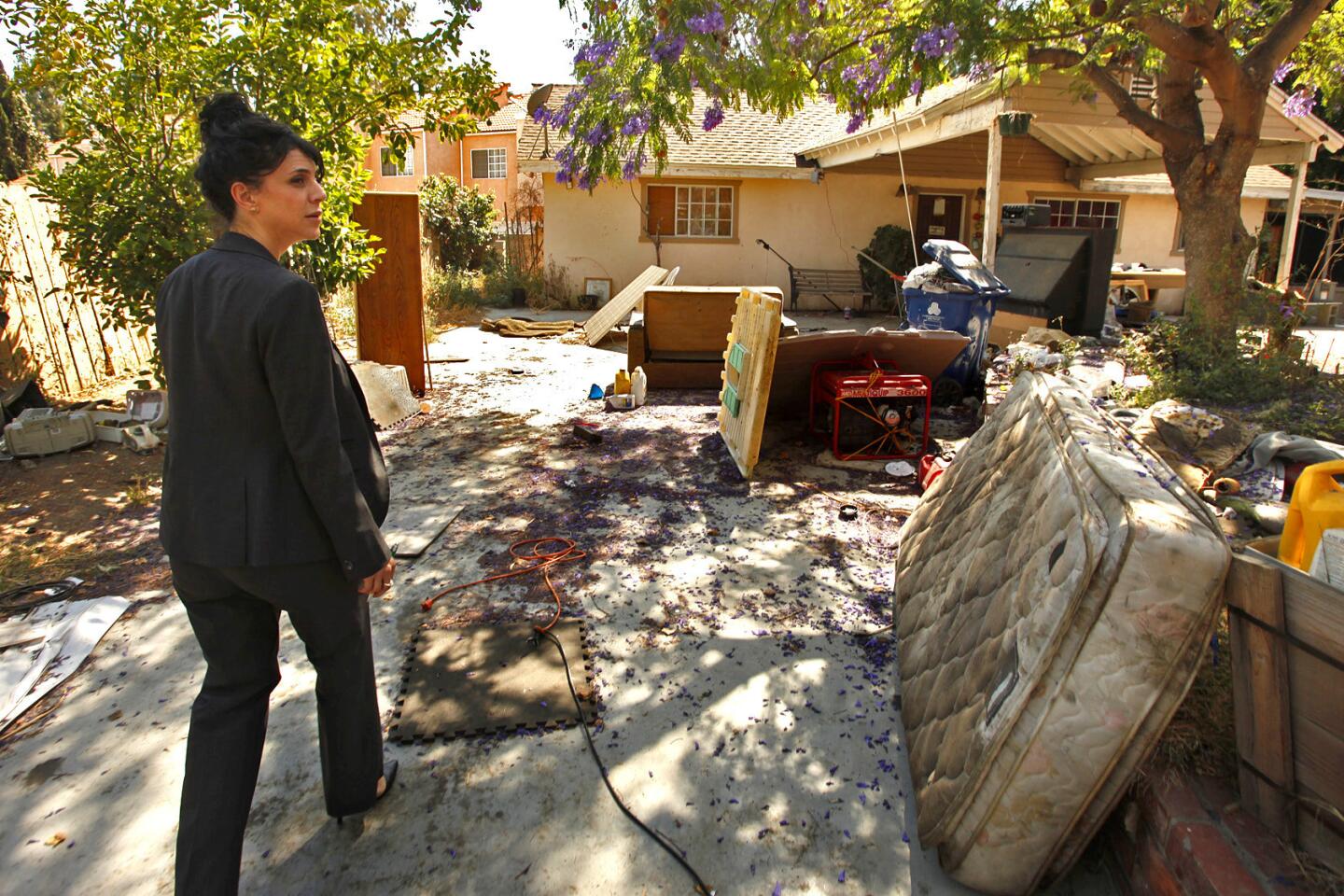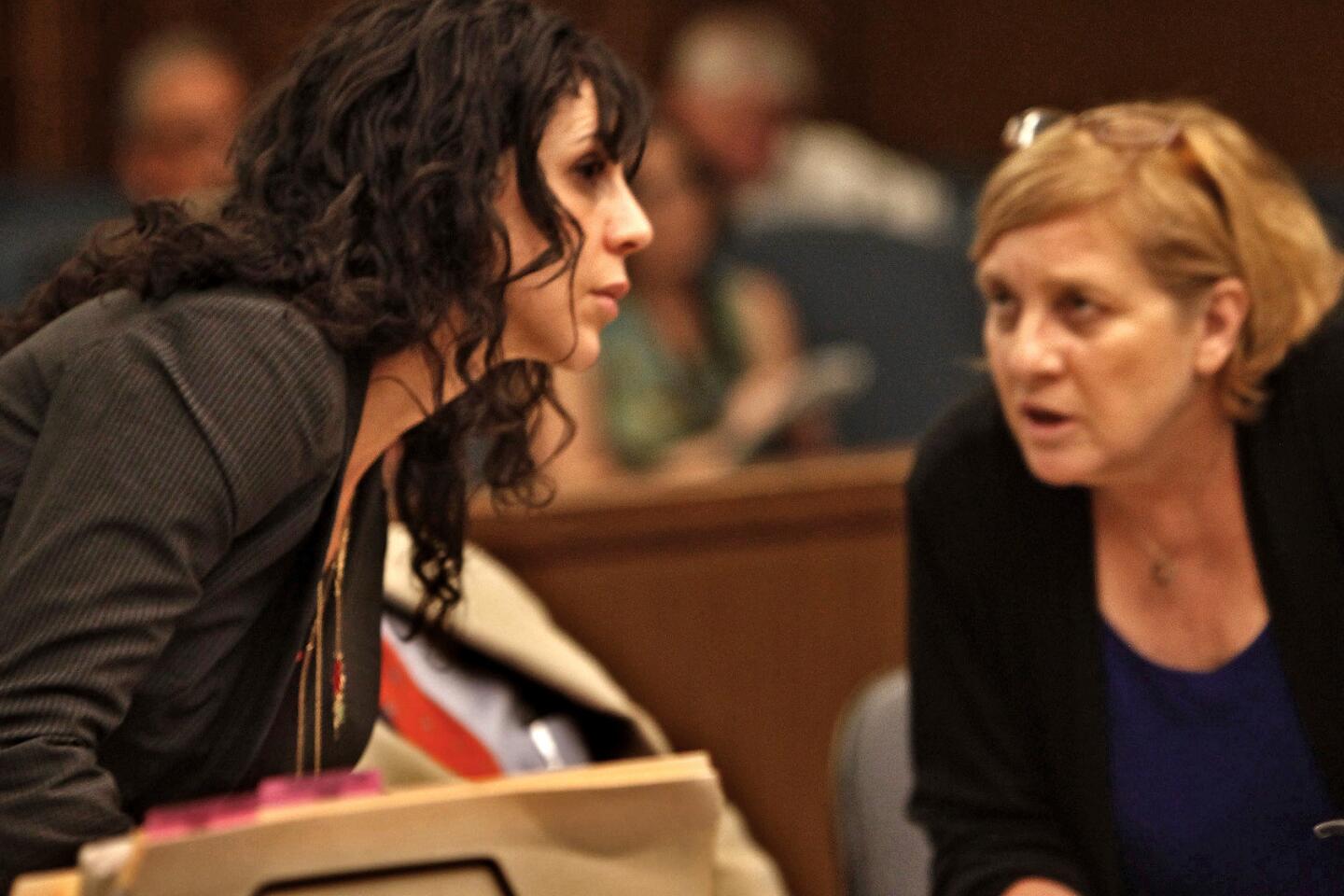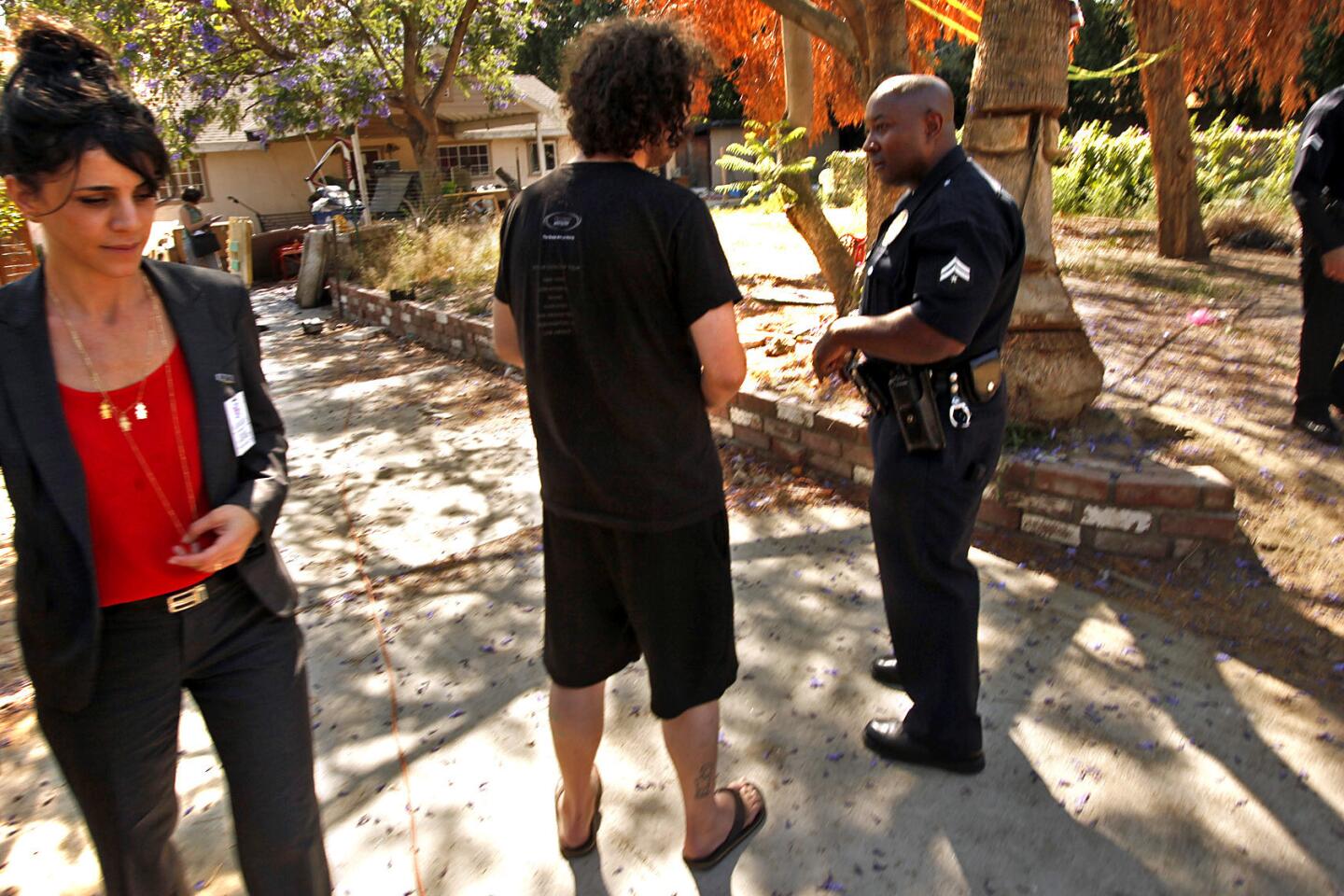L.A. prosecutor’s work goes beyond the courtroom
- Share via
Ayelet Feiman fixed her gaze on the graffiti ringing the highway overpass, thinking out loud.
“Is it Caltrans property?” she asked, a pen poised in one hand, a smartphone dangling from the other. “Is it city property because it’s a city bridge?”
It was a breezy Wednesday afternoon in a Panorama City park, and Feiman was perched above the 405 Freeway. “Even the billboard,” she said, pointing to a defaced sign. “Clearly someone isn’t doing their job.”
Which leaves Feiman to do hers.
In a push to make city government more responsive, Los Angeles City Atty. Mike Feuer has expanded a network of on-the-street attorneys like Feiman, who tackle all manner of quality-of-life menaces across nearly 469 square miles of neighborhoods.
Neighborhood prosecutors like Feiman, a vivacious lawyer with Israeli roots and a Valley upbringing, do battle outside the courtroom as often as in it. They wield the law and weave their way through the city bureaucracy in a struggle against community nuisances, tackling everything from eyesore homes and unkempt shops to rogue peacocks. They pick up tips from officers, business owners and neighborhood groups — or sometimes by just glancing across the freeway.
“We shouldn’t be saying, ‘That’s not my job,’” Feuer said in an interview. “We should be saying, ‘We can step in and fix it, and we will.’”
The long-standing program is on the rebound after years of decline. The number of neighborhood prosecutors, once as high as 22, had dwindled to just eight when Feuer took office last year. During the worst of the cutbacks, Feiman was juggling four police divisions inside and outside the Valley — a swath of the city so big, she said, that she was unable to get deeply involved anywhere.
Now the team of neighborhood prosecutors has doubled to 16, and Feuer plans to hire five more attorneys this year, enough to assign one to each police division.
“In a city as large as Los Angeles, most people find city government very remote, and the justice system even more remote,” he said. “We can change that.”
Feiman now concentrates on neighborhood problems in two divisions in the northern San Fernando Valley. It’s a job that defies simple description. Solving a problem might require Feiman to turn to the county health department to crack down on hoarders piling up trash. She might have to track down a far-flung aunt or uncle to deal with a relative constantly at odds with the law, or seek a helping hand from a nonprofit. She suits up for court in pinstripes and heels, but keeps sneakers stashed in the back of her Mazda, just in case.
She recalls the advice co-workers gave her a decade ago when she took the job: “We’re not really sure how it works.... Be creative.”
On a recent Wednesday, her day began in court, handling a clash between neighbors that had escalated into vandalism, assault and a restraining order. By midmorning, she was hustling to a meeting at Councilman Felipe Fuentes’ Sylmar district office, where she strategized with local officials and police on how to handle problem homes and shops.
One store, blighted by trash and overgrown trees, had become a magnet for aggressive panhandlers. The owner had cleaned it up before — but the same complaints were back.
“The problem with that one is staying on top of him,” said LAPD Senior Lead Officer Alonso Menchaca.
“Maybe I need to make a call again,” Feiman said.
Feiman can take offenders to court, but many of her battles never make it that far. Feiman once nudged a liquor store to move an ice machine indoors to prevent drug dealers from using it to hide their trade. She hopes a simple phone call will spur someone to clean up graffiti on the freeway overpass, without having to flex her legal muscle.
As the sun climbed higher that balmy Wednesday, Feiman joined police to inspect a sprawling Sylmar property where a tower of wooden pallets was stacked perilously high, posing a possible fire hazard. Trucks and trailers cluttered the vast, noisy yard.
“It’s gotten worse. Ten times worse,” a neighbor said as Feiman and two officers gazed over the fence. The woman said she first raised her complaints a year ago, the latest irritant in a neighborhood that has endured cockfighting, drug deals and massive outdoor parties. “I’m ready to get out.”
Feiman said the property owner had a few days left under a city order to clean up. “Obviously, they’re not going to be compliant in four days,” Feiman said.
“So they’re going to get an extension,” the neighbor interjected.
“No, they’re not,” Feiman said firmly.
At lunchtime she headed back to the Mission Community Police Station to log neighborhood nuisances into a computerized system. Some days, she never makes it to her main office at the Marvin Braude Constituent Center in Van Nuys.
“She’s out in the field with us,” said LAPD Capt. Todd Chamberlain, who joined Feiman for a midday meeting at the station about gang reduction. “She sees the problems first-hand.”
Afterward, Feiman stopped by the Casa Esperanza neighborhood center to check in with the staff, asking if they’d heard about cigarettes being sold to children. Later, she joined LAPD officers to revisit more problem properties strewn with junk, in disrepair or suspected of hosting prostitution.
Her battles sometimes continue beyond court. One of her biggest headaches is a haphazardly painted house in the northeast Valley, which Feiman says has become a hangout for drug addicts. She took the owners to court for a code violation — “unlawful use of land” — but little has changed.
“They’re convicted. They’re on probation. And I still don’t have the problem resolved,” Feiman said in exasperation from the back of a police cruiser, eyeing the boarded windows of the still-occupied home. If she were an ordinary prosecutor, she said, her work would be done. “I have to get a little more creative,” she said.
Late in the afternoon, she headed to a community meeting at Marson Street Pocket Park, where she listened as neighbors complained about an unwanted roadside memorial. Feiman promised to find out what they could do, handing out her card around the picnic table. It was there that the graffiti on the overpass caught her eye.
Little things like that nag at her “every time I look around,” Feiman said. It can be overwhelming. “But I see it as a challenge.”
She returned to the station with one more problem to solve.
Twitter: @latimesemily
More to Read
Sign up for Essential California
The most important California stories and recommendations in your inbox every morning.
You may occasionally receive promotional content from the Los Angeles Times.

